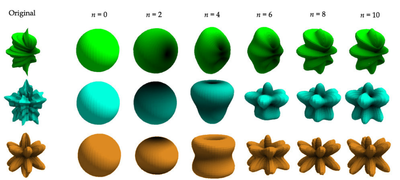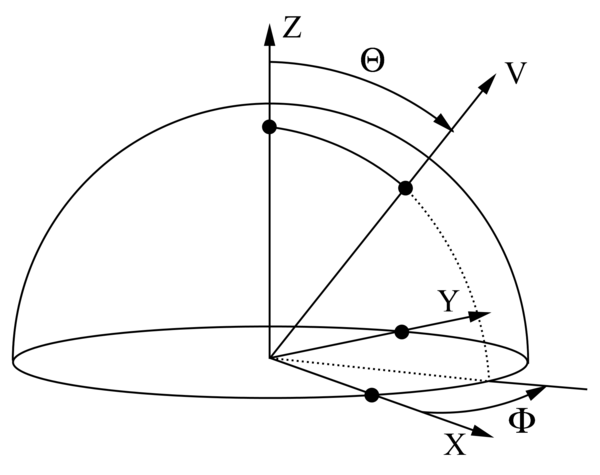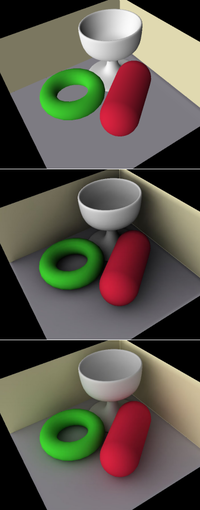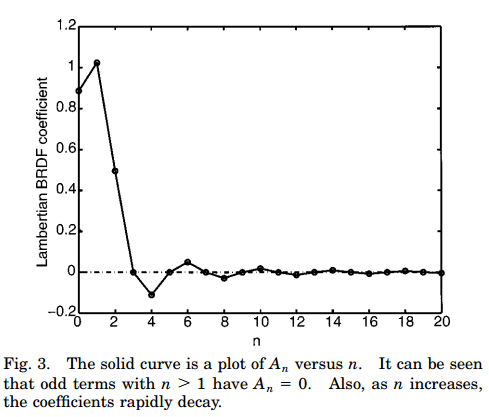| Line 62: | Line 62: | ||
Where <math>K^m_l = \sqrt{ \frac{(2l+1)}{4\pi}\frac{(l-m)!}{(l+m)!}}</math> is a normalization factor and <math>P^m_l(\theta,\phi)</math> is the [https://en.wikipedia.org/wiki/Associated_Legendre_polynomials associated Legendre polynomial] (shown on the right inset figure).<br /> | Where <math>K^m_l = \sqrt{ \frac{(2l+1)}{4\pi}\frac{(l-m)!}{(l+m)!}}</math> is a normalization factor and <math>P^m_l(\theta,\phi)</math> is the [https://en.wikipedia.org/wiki/Associated_Legendre_polynomials associated Legendre polynomial] (shown on the right inset figure).<br /> | ||
| + | |||
| + | |||
| + | [https://en.wikipedia.org/wiki/Legendre_polynomials#Recursive_definition Wikipedia] gives the first Legendre polynomials as: | ||
| + | [[File:LegendrePolynomials.png]] | ||
| + | <br /> | ||
| Line 74: | Line 79: | ||
<br /> | <br /> | ||
| − | |||
| − | |||
| − | |||
Here is a code snippet (source Robin Green's gritty details) about how to build the SH functions: | Here is a code snippet (source Robin Green's gritty details) about how to build the SH functions: | ||
Revision as of 19:59, 3 December 2016
In the early 2000's, people like Ravi Ramamoorthi and Peter-Pike Sloan properly introduced a new powerful and amazing tool to the Computer Graphics industry: Spherical Harmonics (or SH).
Although Spherical Harmonics have always been around for quite some time, for example in the excellent "Predicting Reflectance Functions from Complex Surfaces" 1992 paper from Westin et al., they only piqued the public interest since their introduction as an efficient way of realistic indirect lighting via Pre-computed Radiance Transfer (PRT).
Contents
What are Spherical Harmonics?
According to wikipedia, SH are special functions defined on the surface of a sphere.
In computer graphics, we're using them as a tool to quickly and easily encode or decode a directional information. We use a specific set of spherical harmonics, denoted <math>Y^m_l(\theta,\phi)</math> called Laplace's spherical harmonics.
SH have interesting properties regarding their orthogonality, parity, symmetry and rotation that I will not cover here (cf. the wikipedia page for more info) as this page only is an overview. An excellent source of information is Spherical Harmonics Lighting: the Gritty Details by Robin Green that actually covers the practical use of SH for Computer Graphics, it's a well-explained extension of the original work done by Peter-Pike Sloan about Pre-computed Radiance Transfer (PRT).
I will rather quickly talk about how to construct the SH coefficients and how to encode/decode/convolve signals using SH.
Generalities about SH orders
As can be seen in the inset on the right, Spherical Harmonics are functions defined over the sphere. The SH functions are denoted <math>Y^m_l(\theta,\phi)</math> where <math>l</math> is the order of the function. Since SH define harmonic series, there are an infinite amount of possible orders.
For a given order <math>l</math> you have <math>2l+1</math> coefficients selected by the superscript <math>m\in[-l,+l]</math>. It ensues that the indices and amount of coefficients for each order is then:
0 Order 0 - Total = 1 = 1²
1 2 3 Order 1 - Total = 1 + 3 = 4 = 2²
4 5 6 7 8 Order 2 - Total = 1 + 3 + 5 = 9 = 3²
9 10 11 12 13 14 15 Order 3 - Total = 1 + 3 + 5 + 9 = 16 = 4²
<math>\dots</math>
We quickly see the amount of coefficients to properly represent each order grows quadratically.
Intuitively, we also can notice that the more coefficients we have, the more "directionalities" we can cover. Order 0 is a constant so it represents the "ambient term" — the average response of a signal — and has no specific direction. Coefficients for order 1 represent the response to a signal aligned with the X, Y and Z axes. At order 2, we start covering some diagonal directions and higher frequencies.
In fact, if we used an infinite sum of SH coefficients, we could encode or decode a signal perfectly. A great advantage of using SH is that we can recover a partial signal (i.e. a band-limited signal) and we will obtain a low-frequency representation of that signal, as opposed to wavelets that attempt to reconstruct all frequencies of a signal and can show high-frequency noise, a partial SH-encoded signal will always be smooth.
It is common in real-time computer graphics to use only order 2 (9 coefficients) or order 3 (16 coefficients) at most, each coefficient being a RGB float3 triplet. SH are often used to encode irradiance, which is generally spatially varying pretty smoothly. Although it varies at higher frequency than irradiance, it is also possible to encode the radiance into SH.
Actually, both radiance and irradiance are related in terms of SH, as explained by this great 2001 paper from Ramamoorthi and Hanrahan.
It was shortly followed by another seminal paper called "An Efficient Representation for Irradiance Environment Maps" that extends on the first paper and shows that order 2 SH (9 coefficients) is often enough to properly represent the irradiance field surrounding an object since additional order disappear very quickly. We will come back to these papers later as I will show an extension on this irradiance estimate to introduce the Ambient Occlusion term.
NOTE: It is sometimes desirable to express a SH coefficient <math>Y^m_l(\theta,\phi)</math> by a single index <math>Y_i(\theta,\phi)</math> where <math>i=l(l+1)+m</math>. It can be noted that <math>l(l+1)</math> gives us the "central index" (If you refer to the pyramid of coefficient indices above, these are the bold indices 0, 2, 6, 12, 20, 30, etc.) for any given order <math>l</math>, then adding <math>m</math> will address the "left" or "right" coefficients depending on the sign of <math>m</math>.
Inversely, when we want to retrieve <math>l, m</math> from <math>i</math> then <math>l=\lfloor\sqrt{i}\rfloor</math> and <math>m=i - l(l+1)</math>.
Constructing the SH Coefficients
We're working with a Z-Up orientation:
The expression of vector <math>v</math> in cartesian coordinates is <math>v(\theta,\phi) = (\sin(\theta)\cos(\phi), \sin(\theta)\sin(\phi), \cos(\theta))</math>.
The general spherical harmonics coefficients <math>Y^m_l(\theta,\phi)</math> are expressed as:
- <math>Y^m_l(\theta,\phi) = K^m_l P^m_l(cos(\theta)) e^{im\phi}</math>
Where <math>K^m_l = \sqrt{ \frac{(2l+1)}{4\pi}\frac{(l-m)!}{(l+m)!}}</math> is a normalization factor and <math>P^m_l(\theta,\phi)</math> is the associated Legendre polynomial (shown on the right inset figure).
Wikipedia gives the first Legendre polynomials as:
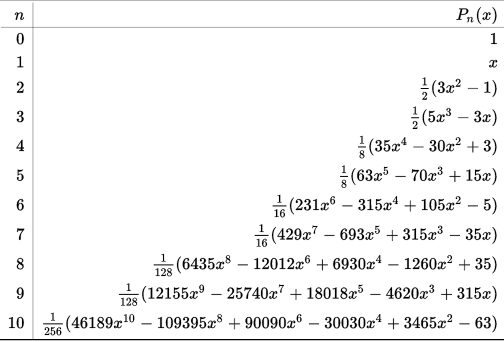
We're interested in the real form of spherical harmonics that is given by:
- <math>Y^m_l(\theta,\phi) =
\begin{cases}
\sqrt{2} K^{-m}_l P^{-m}_l(cos(\theta)) \sin(-m\phi) & \quad \text{if } m < 0\\
K^0_l P^0_l(cos(\theta)) & \quad \text{if } m = 0\\
\sqrt{2} K^m_l P^{| m |}_l(cos(\theta)) cos(m\phi) & \quad \text{if } m > 0\\
\end{cases}
</math>
Here is a code snippet (source Robin Green's gritty details) about how to build the SH functions:
// Renormalisation constant for SH function
double K( int l, int m ) {
double temp = ((2.0*l+1.0)*factorial(l-m)) / (4.0*PI*factorial(l+m)); // Here, you can use a precomputed table for factorials
return sqrt(temp);
}
// Evaluate an Associated Legendre Polynomial P(l,m,x) at x
// For more, see “Numerical Methods in C: The Art of Scientific Computing”, Cambridge University Press, 1992, pp 252-254
double P( int l, int m,double x ) {
double pmm = 1.0;
if ( m > 0 ) {
double somx2 = sqrt((1.0-x)*(1.0+x));
double fact = 1.0;
for ( int i=1; i<=m; i++ ) {
pmm *= (-fact) * somx2;
fact += 2.0;
}
}
if( l == m )
return pmm;
double pmmp1 = x * (2.0*m+1.0) * pmm;
if ( l == m+1 )
return pmmp1;
double pll = 0.0;
for ( int ll=m+2; ll<=l; ++ll ) {
pll = ( (2.0*ll-1.0)*x*pmmp1-(ll+m-1.0)*pmm ) / (ll-m);
pmm = pmmp1;
pmmp1 = pll;
}
return pll;
}
// Returns a point sample of a Spherical Harmonic basis function
// l is the band, range [0..N]
// m in the range [-l..l]
// theta in the range [0..Pi]
// phi in the range [0..2*Pi]
double SH( int l, int m, double theta, double phi ) {
const double sqrt2 = sqrt(2.0);
if( m == 0 ) return K(l,0)*P(l,m,cos(theta));
else if( m > 0 ) return sqrt2*K(l,m)*cos(m*phi)*P(l,m,cos(theta));
else return sqrt2*K(l,-m)*sin(-m*phi)*P(l,-m,cos(theta));
}
Analytical Expressions for the first SH Coefficients
As indicated in the beginning of this page, most real-time applications only use a limited amount of SH orders (2, 3 or more rarely 4 orders) so we're usually dealing with at most 9 or 16 SH coefficients.
These coefficients have analytical expressions that we are now listing below (we dropped the <math>\theta,\phi</math> for conciseness):
- <math>
\begin{cases} \text{order }l=0\\
Y^0_0 = \frac{1}{2}\sqrt{\frac{1}{\pi}}\\
\text{order }l=1\\
Y^{-1}_1 = \frac{1}{2}\sqrt{\frac{3}{\pi}}y & \quad m = -1\\
Y^{0}_1 = \frac{1}{2}\sqrt{\frac{3}{\pi}}z & \quad m = 0\\
Y^{1}_1 = \frac{1}{2}\sqrt{\frac{3}{\pi}}x & \quad m = 1\\
\text{order }l=2\\
Y^{-2}_2 = \frac{1}{2}\sqrt{\frac{15}{\pi}}xy & \quad m = -2\\
Y^{-1}_2 = \frac{1}{2}\sqrt{\frac{15}{\pi}}yz & \quad m = -1\\
Y^{0}_2 = \frac{1}{4}\sqrt{\frac{5}{\pi}}(3z^2-1) & \quad m = 0\\
Y^{1}_2 = \frac{1}{2}\sqrt{\frac{15}{\pi}}xz & \quad m = 1\\
Y^{2}_2 = \frac{1}{4}\sqrt{\frac{15}{\pi}}(x^2-y^2) & \quad m = 2\\
\end{cases} </math>
Where <math>
\begin{cases}
x = \sin(\theta)\cos(\phi)\\ y = \sin(\theta)\sin(\phi)\\ z = \cos(\theta)\\
\end{cases} </math>
Common Usages for SH
Signal Encoding
A signal <math>f(\theta,\phi)</math> whose value is available for all directions can be encoded (or rather, projected) into SH coefficients by estimating the following integral:
- <math>C_i = \int\limits_0^{2\pi}{\int\limits_0^{\pi} {f(\theta,\phi)Y_i(\theta,\phi)\sin(\theta)} \; \mathrm{d}\theta \; \mathrm{d}\phi}</math>
To implement this integration numerically we can use the naïve pseudo-code:
float EncodeSHCoeff( int l, int m ) {
const int STEPS_PHI = 200;
const int STEPS_THETA = 100;
const float dPhi = 2*PI/STEPS_PHI;
const float dTheta = PI/STEPS_THETA;
float coeff = 0.0f;
for ( int i=0; i < STEPS_PHI; i++ ) {
float phi = i * dPhi;
for ( int j=0; j < STEPS_THETA; j++ ) {
float theta = (0.5f+j) * dTheta;
float value = EstimateFunction( phi, theta );
float SHvalue = EstimateSH( l, m, phi, theta )
coeff += value * SHValue * sin( theta ) * dPhi * dTheta;
}
}
return coeff;
}
A better (and faster!) way to do that would be to use importance sampled Monte Carlo sampling. Please refer to Robin Green's paper for details about the technique.
We first need to generate an arbitrary set of samples on the sphere. We choose the samples so that they are uniformly distributed on the sphere, thus ensuring that each sample carries the same weight that will be <math>\frac{4\pi}{N} \text{ where } N \text{ is the amount of samples}</math>:
struct sample_t {
float3 direction;
float theta, phi;
float* Ylm;
};
// Fills an N*N*2 array with uniformly distributed samples across the sphere using jittered stratification
void PreComputeSamples( int sqrt_n_samples, int n_bands, sample_t samples[], float ) {
int i = 0; // array index
double oneoverN = 1.0 / sqrt_n_samples;
for ( int a=0; a < sqrt_n_samples; a++ ) {
for ( int b=0; b < sqrt_n_samples; b++ ) {
// Generate unbiased distribution of spherical coords
double x = (a + random()) * oneoverN; // Do not reuse results
double y = (b + random()) * oneoverN; // Each sample must be random!
double theta = 2.0 * acos( sqrt( 1.0 - x ) ); // Uniform sampling on theta
double phi = 2.0 * PI * y; // Uniform sampling on phi
// Convert spherical coords to unit vector
samples[i].direction = float3( sin(theta)*cos(phi), sin(theta)*sin(phi), cos(theta) );
samples[i].theta = theta;
samples[i].phi = phi;
// precompute all SH coefficients for this sample
for ( int l=0; l < n_bands; ++l ) {
for ( int m=-l; m<=l; ++m ) {
int index = l*(l+1)+m;
samples[i].Ylm[index] = EstimateSH( l, m, theta, phi );
}
}
++i;
}
}
}
We keep that nice array around because we will re-use it for as many encodings as we want by applying that now very straightforward pseudo-code:
typedef double (*EstimateFunction)( double theta, double phi );
// Here, n_coeffs = n_bands*n_bands and n_samples = sqrt_n_samples*sqrt_n_samples
void SHProject( EstimateFunction estimator, int n_samples, int n_coeffs, const sample_t samples[], double result[] ) {
for ( i=0; i < n_coeff; ++i ) {
result[i] = 0.0;
// For each sample
for ( int i=0; i < n_samples; ++i ) {
double theta = samples[i].theta;
double phi = samples[i].phi;
for ( int n=0; n < n_coeff; ++n ) {
result[n] += estimator( theta, phi ) * samples[i].Ylm[n];
}
}
// Divide the result by weight and number of samples
double factor = 4.0*PI / n_samples;
for ( i=0; i < n_coeff; ++i ) {
result[i] = result[i] * factor;
}
}
NOTE: Projecting a function into SH coefficients is obviously not something we want to be doing every frame! The goal is to project once, and re-use the SH coefficients all around. The memory gain is enormous: for example imagine you want to encode a distant environment cube map into an order 2 SH to use it as the diffuse radiance source, then assuming you're dealing with a 256x256x6xRGB32F cube map, you start from a 256*256*6*16 = 6 solid Mega Bytes down to a mere 9*12 = 108 Bytes (9 float3 SH coefficients).
Of course, encoding with so little coefficients is sufficient enough for diffuse irradiance estimates and barely anything else, don't expect a great many deal of details out of that!
Signal Decoding
To reconstruct the band-limited version of the original signal from a bunch of SH coefficients, you simply need to apply the inverse transform:
<math>f(\theta,\phi) \; \simeq \; \displaystyle\sum_{l=0}^{N} \displaystyle\sum_{m=-l}^{l} C_l^m Y_l^m(\theta,\phi)\sin(\theta) \text{ where } N \text{ is the SH order}</math>
NOTE: we used the <math>\simeq</math> sign here because unless <math>N=\infty</math> we will only be able to reconstruct a band-limited, low-frequency version of the original signal.
Signal Convolution / Signal Product
This property is certainly the most important regarding SH.
In computer graphics it's often that we need to compute that kind of integral:
- <math>\int\limits_\Omega{A(\boldsymbol\omega_i) B(\boldsymbol\omega_i) \; \mathrm{d\omega_i}}</math>
Where:
- <math>
\Omega \text{ represents the set of all directions on the sphere}\\
A(\boldsymbol\omega_i) \text{ and } B(\boldsymbol\omega_i) \text{ represent 2 arbitrary functions evaluated in direction } \boldsymbol{\omega_i} \text{ that are multiplied together}\\
\boldsymbol{\omega_i} \text{ is the unit integration vector (i.e. the incoming direction)}\\
\mathrm{d\omega_i} \text{ is the solid angle (a scalar!) in the incoming direction}\\
</math>
Well, assuming you managed to encode <math>A(\boldsymbol\omega_i)</math> into SH coefficients <math>a_l^m</math> and similarly you obtained the <math>b_l^m</math> SH coefficients corresponding to the <math>B(\boldsymbol\omega_i)</math> signal then the integral in terms of SH simply is:
- <math>\int\limits_\Omega{A(\boldsymbol\omega_i) B(\boldsymbol\omega_i) \; \mathrm{d\omega_i}} \; = \; \displaystyle\sum_{l=0}^{\infty} \displaystyle\sum_{m=-l}^{l} a_l^m \, b_l^m</math>
So we basically reduced a difficult integral computation into a simple dot product!
Note the exact equal sign only stands because we have an infinite number of SH coefficients here. With a finite number, say 9 or 16, we can only obtain an incomplete, band-limited version of the signal...
Irradiance Estimate Example
The integration of radiance into irradiance over the hemisphere is:
- <math>E(\mathbf n) = \int\limits_\Omega{L(\boldsymbol{\omega_i}) \lfloor (\boldsymbol\omega_i\cdot\mathbf n )\rfloor \; \mathrm{d\omega_i}}</math>
Where:
- <math>
L(\mathbf n,\boldsymbol{\omega_i}) \text{ is the radiance arriving in incoming direction } \boldsymbol{\omega_i}\\
E(\mathbf n) \text{ is the irradiance perceived in direction } \mathbf{n}\\
\mathbf n \text{ is the surface normal direction}\\
\lfloor (\mathbf\omega_i\cdot\mathbf n)\rfloor \text{ represents the dot product clamped over the upper hemisphere}
</math>
Assuming you have a SH representation of the surrounding radiance, for example coming from a cube map, then it is easy to analytically compute the SH coefficients for the clamped cosine.
This is exactly the purpose of the 2001 paper by Ramamoorthi et al. that we will discuss below
Pre-computed Radiance Transfer Example
Another example is the surface radiance estimate:
- <math>L(\boldsymbol{\omega_o}) = \int\limits_{\Omega^+}{L(\boldsymbol{\omega_i}) \, f_r( \boldsymbol{\omega_o}, \boldsymbol{\omega_i} ) \, (\boldsymbol\omega_i\cdot\mathbf n ) \; \mathrm{d\omega_i}}</math>
Where:
- <math>
L(\boldsymbol{\omega_i}) \text{ is the radiance arriving in incoming direction } \boldsymbol{\omega_i}\\
L(\boldsymbol{\omega_o}) \text{ is the radiance leaving in outgoing direction } \boldsymbol{\omega_o}
</math>
- <math> f_r( \boldsymbol{\omega_o}, \boldsymbol{\omega_i} )</math> is the surface's BRDF
- <math> \Omega^+ \text{ represents the upper hemisphere of directions (so there is no need for the clamped dot product here!)}\\</math>
Again, assuming you have a SH representation of the surrounding radiance (e.g. coming from a cube map or some indirect lighting computation) that we will call <math>L_l^m</math> and also a SH representation of the BRDF and cosine term that we will call <math>T_l^m</math>, the encoded "transfer function", then the outgoing radiance simply is:
- <math>L(\boldsymbol{\omega_o}) \; = \; \displaystyle\sum_{l=0}^{\infty} \displaystyle\sum_{m=-l}^{l} L_l^m \, T_l^m</math>
Once again we warn about the exact equal sign. In practice, the radiance environment and "BRDF+cosine term" transfer functions are encoded with only a few SH coefficients and can thus only represent very low-frequency environments.
This is why the SH PRT technique is generally only used to encode slowly varying transfer functions like the diffuse BRDF <math>\frac{\rho}{\pi}</math> where <math>\rho</math> represents the surface's reflectance.
Anyway, you can immediately see the beauty and strong interest SH can bring to the table: you can pre-compute a (distant) lighting environment in term of SH and place any object within that environment, assuming you know the transfer function for every part of the object you want to light.
For example:
- If the transfer function simply is the BRDF*cosine term as mentioned above, then your object will simply be directly lit by the environment as is normally the case with standard lighting
- But the interesting part is that, since the transfer function could be anything, it may as well be the BRDF*cosine term plus what the object perceives of its environment: you would then obtain the direct lighting plus a first bounce of indirect lighting and even shadowing!
This is illustrated by the image on the right where we increase the realism of the scene's lighting. What's even better is that we can completely change the surrounding lighting environment on the fly at any time for absolutely no cost at all!
You can see an example of that technique in my StJean cathedral project (requires WebGL!).
In the cathedral, I stored 2 bands (order 1 = 4 coefficients) of the pre-computed radiance transfer coefficients for every vertex of the cathedral.
NOTE: Although it seems cool to do that, it's pretty heavy for real game scenes that now use tens of millions of vertices, it's also pretty long to pre-compute since you must ray-trace the scene from every vertex and finally, it's limited to a static environment...
Signal Triple Product
Sometimes we will want to perform another very important operation that takes 2 SH representations of a signal as input and outputs a new SH representation as output: that is called the "triple product".
A basic example would be:
- You have the SH coefficients <math>A_i</math> for the (dynamic) ambient lighting in your environment (e.g. the unoccluded sky light)
- You also have the pre-computed SH coefficients <math>B_i</math> representing (static) local shadowing of the environment (e.g. you're inside a room and the environment is only perceived through a door)
- And you want to dynamically obtain the SH coefficients <math>C_i</math> for the "shadowed ambient lighting" (e.g. the occluded sky light that you perceive through the door)
This is a rather complicated operation involving the transfer matrix:
- <math>
\mathbf{M_{ij}} \; = \; \int\limits_{\Omega} {B(\boldsymbol{\omega_i}) Y_i({\omega_i}) Y_j({\omega_i}) \; \mathrm{d\omega_i}}
</math>
Then:
- <math>
C_i \; = \; \displaystyle\sum_{j=0}^{N^2} A_i \; \mathbf{M_{ij}} </math>
The main problems are:
- We don't want to store a matrix for every vertex in the scene! (although the matrix is very sparse, storing SH coefficients for every vertex is already heavy!)
- We don't want to perform a matrix multiplication for every vertex either!
- Computing the matrix coefficients can be pretty involved as it features some funny stuff like Clebsch-Gordan coefficients and Wigner 3-j symbols...
So basically, this technique is pretty heavy and shouldn't be used very often, certainly not at every vertex of a scene!
You can find the code to compute the triple-product of 2 sets of SH coefficients in the excellent 2006 paper by John Snyder.
Here is the HLSL version of that code cleaned up for only 9 coefficients:
// Performs the SH triple product r = a * b
// From John Snyder (appendix A8)
//
void SHProduct( const in float4 a[9], const in float4 b[9], out float4 r[9] ) {
float4 ta, tb, t;
const float C0 = 0.282094792935999980;
const float C1 = -0.126156626101000010;
const float C2 = 0.218509686119999990;
const float C3 = 0.252313259986999990;
const float C4 = 0.180223751576000010;
const float C5 = 0.156078347226000000;
const float C6 = 0.090111875786499998;
// [0,0]: 0,
r[0] = C0*a[0]*b[0];
// [1,1]: 0,6,8,
ta = C0*a[0]+C1*a[6]-C2*a[8];
tb = C0*b[0]+C1*b[6]-C2*b[8];
r[1] = ta*b[1]+tb*a[1];
t = a[1]*b[1];
r[0] += C0*t;
r[6] = C1*t;
r[8] = -C2*t;
// [1,2]: 5,
ta = C2*a[5];
tb = C2*b[5];
r[1] += ta*b[2]+tb*a[2];
r[2] = ta*b[1]+tb*a[1];
t = a[1]*b[2]+a[2]*b[1];
r[5] = C2*t;
// [1,3]: 4,
ta = C2*a[4];
tb = C2*b[4];
r[1] += ta*b[3]+tb*a[3];
r[3] = ta*b[1]+tb*a[1];
t = a[1]*b[3]+a[3]*b[1];
r[4] = C2*t;
// [2,2]: 0,6,
ta = C0*a[0]+C3*a[6];
tb = C0*b[0]+C3*b[6];
r[2] += ta*b[2]+tb*a[2];
t = a[2]*b[2];
r[0] += C0*t;
r[6] += C3*t;
// [2,3]: 7,
ta = C2*a[7];
tb = C2*b[7];
r[2] += ta*b[3]+tb*a[3];
r[3] += ta*b[2]+tb*a[2];
t = a[2]*b[3]+a[3]*b[2];
r[7] = C2*t;
// [3,3]: 0,6,8,
ta = C0*a[0]+C1*a[6]+C2*a[8];
tb = C0*b[0]+C1*b[6]+C2*b[8];
r[3] += ta*b[3]+tb*a[3];
t = a[3]*b[3];
r[0] += C0*t;
r[6] += C1*t;
r[8] += C2*t;
// [4,4]: 0,6,
ta = C0*a[0]-C4*a[6];
tb = C0*b[0]-C4*b[6];
r[4] += ta*b[4]+tb*a[4];
t = a[4]*b[4];
r[0] += C0*t;
r[6] -= C4*t;
// [4,5]: 7,
ta = C5*a[7];
tb = C5*b[7];
r[4] += ta*b[5]+tb*a[5];
r[5] += ta*b[4]+tb*a[4];
t = a[4]*b[5]+a[5]*b[4];
r[7] += C5*t;
// [5,5]: 0,6,8,
ta = C0*a[0]+C6*a[6]-C5*a[8];
tb = C0*b[0]+C6*b[6]-C5*b[8];
r[5] += ta*b[5]+tb*a[5];
t = a[5]*b[5];
r[0] += C0*t;
r[6] += C6*t;
r[8] -= C5*t;
// [6,6]: 0,6,
ta = C0*a[0];
tb = C0*b[0];
r[6] += ta*b[6]+tb*a[6];
t = a[6]*b[6];
r[0] += C0*t;
r[6] += C4*t;
// [7,7]: 0,6,8,
ta = C0*a[0]+C6*a[6]+C5*a[8];
tb = C0*b[0]+C6*b[6]+C5*b[8];
r[7] += ta*b[7]+tb*a[7];
t = a[7]*b[7];
r[0] += C0*t;
r[6] += C6*t;
r[8] += C5*t;
// [8,8]: 0,6,
ta = C0*a[0]-C4*a[6];
tb = C0*b[0]-C4*b[6];
r[8] += ta*b[8]+tb*a[8];
t = a[8]*b[8];
r[0] += C0*t;
r[6] -= C4*t;
// entry count=13
// multiply count=120
// addition count=74
}
About Distant Radiance and Irradiance Environments
So let's delve deeper into Ramamoorthi's paper that establishes the relationship between radiance and irradiance in terms of SH coefficients.
Estimating the lambertian BRDF SH coefficients
Ramamoorthi states that irradiance <math>E(\mathbf n )</math> reflected by a diffuse Lambertian surface is written:
- <math>E(\mathbf n) \; = \; \int\limits_{\Omega(\mathbf n)} L(\boldsymbol{\omega_i})\lfloor(\mathbf n \cdot \boldsymbol{\omega_i})\rfloor \; \mathrm{d\omega_i} \qquad (1)</math>
Where:
- <math>
E(\mathbf n) \text{ represents the irradiance estimate along normal direction } \mathbf n\\
L(\boldsymbol{\omega_i}) \text{ represents the radiance along incoming direction } \boldsymbol{\omega_i}\\
\Omega(\mathbf n) \text{ is the set of all possible directions over the sphere centered about normal vector } \mathbf n
</math>
We can write radiance and irradiance in terms of SH coefficients as:
- <math>L(\mathbf n) \; = \; \displaystyle\sum_{l,m} L_l^m \, Y_l^m(\mathbf n) \qquad (2)</math>
- <math>E(\mathbf n) \; = \; \displaystyle\sum_{l,m} E_l^m \, Y_l^m(\mathbf n) \qquad (3)</math>
We saw earlier that the SH product allowed us to estimate integrals like (1) above: assuming <math>A(\theta_i) = \lfloor(\mathbf n \cdot \boldsymbol{\omega_i})\rfloor = \lfloor\cos(\theta_i)\rfloor</math> is representing the transfer function defined over the entire sphere (with clamping so it's 0 in the lower hemisphere) then:
- <math>A(\cos(\theta_i)) \; = \; \lfloor\cos(\theta_i)\rfloor \; = \; \displaystyle\sum_{l=0}^\infty A_l Y_l^0(\cos(\theta_i))</math>
Notice here that we don't use the azimuthal dependence on <math>\phi</math> since the cosine lobe is symmetrical about the vertical axis <math>z</math>: we call this special kind of SH, those with m=0, the Zonal Harmonics (or ZH). They are defined by a single index <math>l</math> defining the order of the ZH.
The coefficients are given by:
- <math>
\begin{equation}
A_l \, = \, \int\limits_0^{2\pi} \int\limits_0^\pi \lfloor\cos(\theta_i)\rfloor Y_l^0(\theta_i) \sin(\theta_i) \; \mathrm{d\theta_i} \; \mathrm{d\phi_i}\\
= 2\pi \int\limits_0^{\frac{\pi}{2}} \cos(\theta_i) Y_l^0(\theta_i) \sin(\theta_i) \; \mathrm{d\theta_i} \qquad (4) \quad \text{ (notice we changed the integration interval and got rid of the floor operator)}
\end{equation}
</math>
Now if we expand <math>Y_l^0(\theta)</math> in terms of Legendre polynomials we get:
- <math>Y_l^0(\theta) \, = \, \sqrt{\frac{2l+1}{4\pi}} \, P_l(\cos(\theta))</math>
We can then rewrite (4) as:
- <math>A_l \, = \, 2\pi \sqrt{\frac{2l+1}{4\pi}} \int\limits_0^{\frac{\pi}{2}} P_l(\cos(\theta_i)) \cos(\theta_i) \sin(\theta_i) \; \mathrm{d\theta_i} \qquad (5)</math>
Letting <math>u=\cos(\theta_i)</math> and noting that <math>\cos(\theta_i)P_1(\cos(\theta_i))</math> (or <math>P_1(u)=u</math> now), we obtain:
- <math>A_l \, = \, 2\pi \sqrt{\frac{2l+1}{4\pi}} \int\limits_0^1 P_l(u) P_1(u) \; \mathrm{du} \qquad (6)</math>
Notice once again the integration interval changed: it was reversed because of the minus sign coming with the fact that <math>\mathrm{du}=-\sin(\theta_i) \mathrm{d\theta_i}</math>.
Performing a numerical integration of the first 20 ZH orders, we can plot the values of the Lambertian BRDF coefficients <math>A_l</math> (from Ramamoorthi):
Ramamoorthi notices that:
- for <math>l=1 : \qquad A_1 = \sqrt{\pi/3}</math>
- for <math>n>1, odd : \quad A_n = 0</math>
- for <math>n>1, even : \quad A_n = 2\pi\sqrt{\frac{2l+1}{4\pi}} \frac{(-1)^{l/2-1}}{(l+2)(l-1)} \lfloor{\frac{l!}{2^l(l!/2)^2}}\rfloor</math> and decreases very rapidly (<math>A_l \propto l^{-2}</math>)
Rewriting the diffuse reflection in terms of SH
We can now write the SH version of the diffuse reflection integral (1) from the previous section:
- <math>E(\theta_n, \phi_n) \; = \; \displaystyle\sum_{l,m} L_l^m \, A_l \, \times [-R^l_{m,0}(\theta_n) \sin(m \phi_n)] \qquad (7)</math>
I skipped the description of the full rotation of the incoming lighting but it now comes into play as the expression <math>-R^l_{m,0}(\theta_n) \sin(m \phi_n)</math> where <math>R^l_{m,0}(\theta_n)</math> represents a <math>(2l+1)\times(2l+1)</math> matrix that tells us how a SH transforms under rotation about the Y axis, i.e., how to rewrite a rotated SH as a linear combination of all the SH of the same order.
This matrix is further simplified by the fact that the transfer function <math>A = \cos(\theta_n)</math> has no azimuthal dependence so terms with <math>m'\neq0</math> will vanish.
It can be shown that:
- <math>-R^l_{m,0}(\theta_n) sin(m \phi_n) \, = \, \sqrt{\frac{4\pi}{2l+1}} Y_l^m(\theta_n, \phi_n)</math>
So we can finally rewrite equation (7) as:
- <math>E(\theta_n, \phi_n) \; = \; \displaystyle\sum_{l,m} \sqrt{\frac{4\pi}{2l+1}} \, A_l \, L_l^m \, Y_l^m(\theta_n, \phi_n) \qquad (8)</math>
And since we know from equation (3) that:
- <math>E(\mathbf n) \; = \; \displaystyle\sum_{l,m} E_l^m \, Y_l^m(\mathbf n)</math>
We can thus write:
- <math>E_l^m \, = \, \sqrt{\frac{4\pi}{2l+1}} \, A_l \, L_l^m</math>
Extension to account for the Ambient Occlusion term
@TODO:
- AO term
- Use AO term also for estimate against predefined directions => cone should be used here as well!
- Legendre function defined in non-integer degree: https://en.wikipedia.org/wiki/Legendre_function (fractional calculus, non-integer derivatives and the gamma function)
Archives
You can find an explanation about my old SH Environment Maps technique (2009).
Precious References
- "Predicting Reflectance Functions from Complex Surfaces" (1992) Stephen Westin et al.
- "On the relationship between radiance and irradiance: determining the illumination from images of a convex Lambertian object" (2001) Ravi Ramamoorthi and Path Hanrahan
- "An Efficient Representation for Irradiance Environment Maps" (2001) Ravi Ramamoorthi and Path Hanrahan
- "Precomputed Radiance Transfer for Real-Time Rendering in Dynamic, Low-Frequency Lighting Environments" (2002) Peter-Pike Sloan et al.
- "Spherical Harmonics Lighting: the Gritty Details" (2003) Robin Green
- "Stupid Spherical Harmonics Tricks" (2008) Peter-Pike Sloan et al.
- "Code Generation and Factoring for Fast Evaluation of Low-order Spherical Harmonic Products and Squares" (2006) John Snyder

